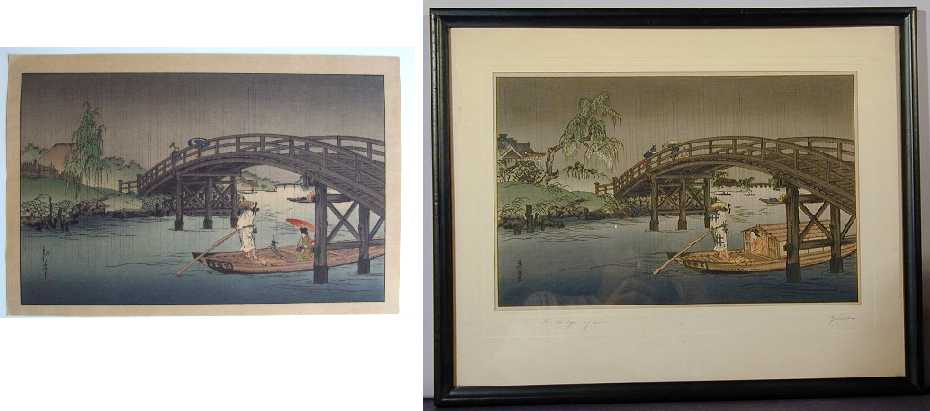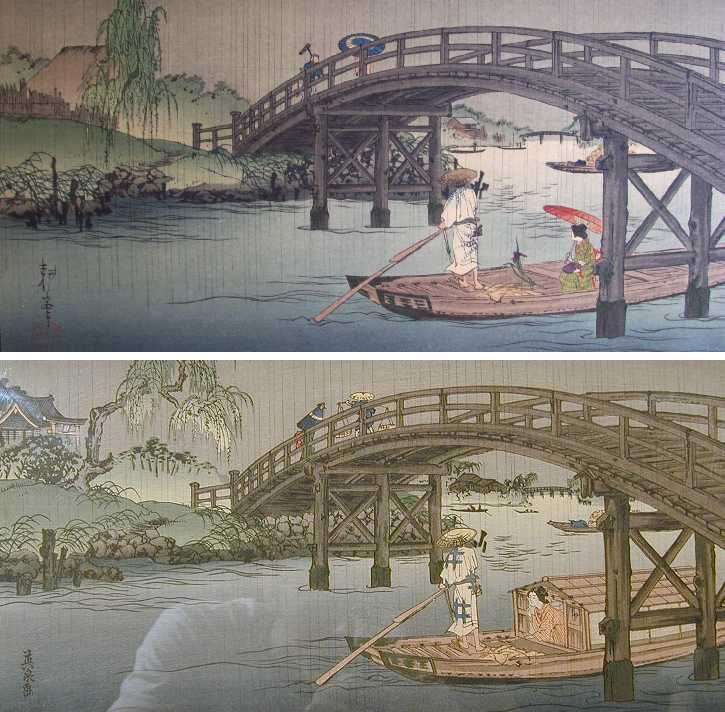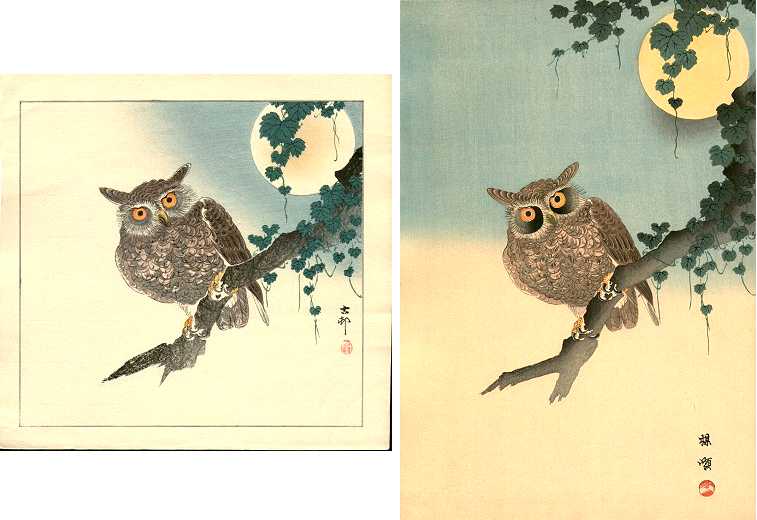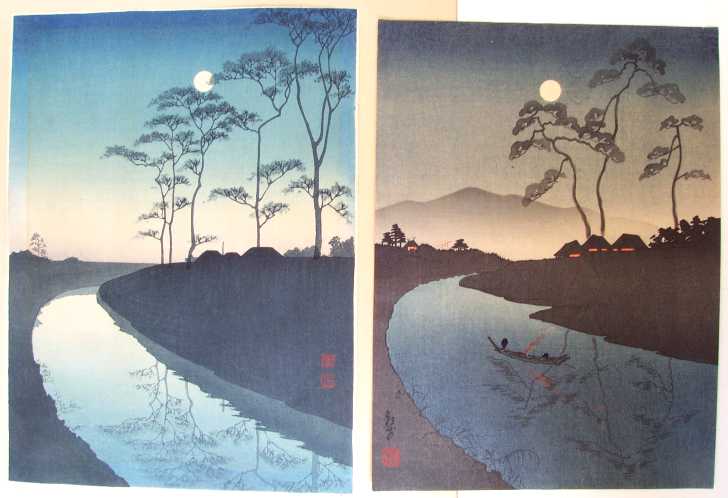"Still MORE Look-Alike" Prints.... A Few Further Examples
Continuing with our earlier Ukiyoe-Gallery.com Article #42,
"Look-Alike" Prints of the Early "Shin-Hanga" Era,"
and Article #44,
"MORE Look-Alike" Prints of the Early "Shin-Hanga" Era,"
we will now examine three additional interesting examples of "look-alike"
prints of the early 1900's "shin-hanga" era. As with our previous examples, encounters with these prints
provide a fascinating study--and while we will likely never know the full story of their evolution and production, it
continues to be an endlessly fascinating pastime to recognize and study these prints.
As previouly then, armed with some knowledge prints, some reasonable assumptions, and a bit of common sense,
we can then make some rational speculations as to the evolution of these prints. Without again repeating many of the
reasoned speculations of our prior two articles, let's now move on to some further examples.
Additional Examples of "Look-Alike" Prints
Koho's "A Bridge in the Rainy Season" and a "Look-Alike" Print
As this article's first example, we will now present a strikingly similar and interesting "look-alike" copy of Koho's
"oban-sized" (9 x 14 inch)
image titled "A Bridge in the Rainy Season." This rarely encountered scene of old Japan
was published by Hasegawa Publisher, who is perhaps best known for their chuban-sized (7 x 10 inch) series of 21
"Night Scenes" prints produced during the early
1910-20's period. Of the same vintage, our subject print "A Bridge in the Rainy Season" is listed in the early
1920's "Hasegawa Catalogue" and is seen just below on the left. Our "look-alike" print is one that we have only
examined via digital images, sent to us several years ago by a viewer (hence, we apologize for the minor
"reflection" seen in this image).

Koho's ca1910-20's "A Bridge in the Rainy Season" print above a "Look-Alike" Print (ca1910-30's)
As with many other examples of "look-alike" prints, so similar are these two prints in their size, colors, and overall
composition, that--IF viewed individually--the casual observer could easily then assume that they were the "exact same
print." That is, however, until they are set side-by-side for a somewhat closer look.....at which point some
some obvious differences are noted. Perhaps most readily apparent is the differences seen the "look-alike" print's
large boat. No longer an open boat, the print to the left now appears with a small covered cabin often seen on
pleasure boats. Upon further inspection, one then also begins to notice that the large distant tree (and farmhouse
behind) had been moved and enlarged slightly.
As with previous examples, let's now "zoom in" for a closer look......

A Closer Look at Koho's "A Bridge in the Rainy Season" Print (top) and the "Look-Alike" Eisen Print (bottom)
Focusing now a bit closer on some of the smaller details of these two prints, we do notice a few more minor differences
in their design. Perhaps most notable is that the Koho print's two travelers seen crossing the bridge are "reversed"
somewhat, with the worker (now also carrying different "loads") and the bijin with umbrella having changed positions.
Also somewhat changed are the pole-pilings seen across on the riverbank's left shoreline. These differences noted,
much of the remainder of the "look-alike" print's design (including the distant details seen under the bridge) remains
largely unchanged, with the exception of only minor "elemental" differences. horizon line have also be varied somewhat, but overall are still remarkably
similar.
What is perhaps most striking to us with respect to these two prints is how seemingly "identical" are the bridge
structures and detailings seen in both prints. Unfortunately, we have not had this "look-alike" print physically
in-hand to make a direct print-to-print size comparison--but we strongly suspect that if these two prints were OVERLAID, their
bridges would then prove to be IDENTICAL as to both size and proportion. That said, we suspect that an actual Koho
"Bridge" print was either "traced" onto tissue paper...... or perhaps even glued face-down (thusly "reversed") and
physically carved through (destroyed) to produce the "identical bridge" seen in our copy. Such "sacrificing" of
original prints--by gluing them down backwards onto a blank uncarved cherrywood block--was one common means by
which Japanese artisans of the late-1800's/early-1900's were able to produce in some cases nearly identical
"counterfeit copies" of original ukiyo-e prints.
Speaking of "old ukiyo-e prints," one final examination of our "look-alike" print is further revealing...... The black
Japanese "signature" seen in its lower left corner reads "Eisen-ga"--a common trick employed during the early 1900's
to in some way to further "add value" to these prints. Of course, Eisen (1790-1848) was well-known to early collectors
of ukiyo-e prints, and along with the prints of his contemporary Eizan (1787-1867), both of these artists' "bijini-ga"
prints were eagerly sought-after by collectors. Hence, showing the "name" of a well-known artist (Hiroshige's name
is also commonly used) was often done to increase the desirability of such prints.
Although no "publisher's identification" is seen on the front of our "look-alike" print, we are unable to say for
certain whether or not any identifiable markings are present on its somewhat unseen margins or verso. However, we
speculate that most likely no publisher's information is given, as is typically the case with such "look-alike" prints.
UPDATE: At the time during which this article was being prepared, we have learned that this "look-alike" Eisen
print is listed (and illustrated) in the "Shima Art Company -- Catalogue of Prints" at our good friend Marc Kahn's
"Shotei.com" website. There we learn more: that this print bears "no seal of Shima
(Publisher);" its size (given as 22 x 35.5cm) IS the same as our Koho print (hence, again suggesting tracing); and
is attributed as being "after a design by Shoda Koho."
Of course, it is impossible for an artist who died in 1848 (Eisen) to have actually produced a print design "after"
an artist who lived at a later time (Koho lived 1870-1946). In other words, as with many of the other Shima Art Company
prints, the "signatures" of earlier well-known artists were displayed on these prints simply in an attempt to "enhance"
their value to print collectors.
To learn more about the "Shima Art Company," a good read
are the various articles that Marc co-authored with Kotaro Sumii, who is the grandson of Torazo Shima who in 1908
founded the Shima Art Company.
Deliberate and Observable Differences.....
Repeating largely from our earlier article #44.....
To us at least, this above example seems to again validate our earlier article's assumption that (although we do NOT claim to be familiar
with Japanese copyright laws of this period) the body of evidence encountered continues to indicates that as long as deliberate and
observable differences were incorporated into a copied print's design, it was at that time apparently then not considered (we assume "legally")
to have been a "copy." Although the above (in this case, unquestionably fraudulently "signed" as "Eisen")
"look-alike" print is speculated on our part to be lacking ANY publisher's identification, we further believe that
publishers of such prints deliberately incorporated "design differences" into their prints to further "protect"
themselves from legal disputes. (Speculation on our part?? YES....
but we believe also certainly a reasonable assumption based on our observations.) Certainly if this unknown publisher HAD desired to
a "more exact" copy, this could have been easily achieved. Apparently there were "reasons" for not doing so.
Koson's 1910-23 "Scops Owl on Branch, Full Moon" Print and Kono Bairei's "look-alike" Print
As this article's second example, we will now present a recently encountered "look-alike" that came as even a surprise to us. Viewed as
an offering in a recent December on-line auction was a print that immediately caught our eye. The well-known 1933 nighttime Hasui street
scene titled "Evening at Soemoncho, Osaka" of which many viewers are already familiar, in fact it seems, has a "look-alike" copy. Although
we were unfortunately not able to view the "look-alike" print firsthand, we will show and tell you what we can. Both prints are seen just below.

Koson's 1910-23 "Scops Owl on Branch, Full Moon" Print and
Kono Bairei's "look-alike" Print
Of course, Koson's 1910-23 "Scops Owl on Branch, Full Moon" print is reasonably well documented
("Crows, Cranes and Camellias: The Natural World of Ohara Koson"),
so we know that it is a Daikoku-ya Publisher print of the ca1910-23 period (Daikoku-ya Publisher ceased business in
1923 following the devastating Great Kanto Earthquake).
As with many of the shin-hanga prints of this early 1900's period, some of the most popular print's designs were
copied (at least to some degree of similarity) by other publishers. Of course, in the cases of publishers that had
suddenly gone out of business, this provided a virtual carte blanche opportunity to copy popular designs. This
seems to have been the case with several of the "kacho-e" designs of Daikoku-ya Publisher.
Turning next to our quite similar "look-alike" print, we first note that in this case it does bear a readily recognizable
"publisher's seal"--the round red seal of Shima Art Company.
Our artist in this case is Bairei KONO (1844-1895; aka, Bairei YASUDA) who is known to have produced a large volume of
"kacho-e" (bird and flower) prints.
In this case, however, although Bairei was active as an artist much earlier than Koson (at the time of Bairei's death in
1895, Koson was then only 17 years of age), we strongly suspect that this Bairei "design" was, in fact, LATER copied from
the Koson design by artisans of the Shima Art Company. After the fact then, the well-known "kacho-e artist" name of
"Bairei" was simply added to the print.
UPDATE: Again, at the time during which this article was being prepared, we have learned that this "look-alike" Bairei
print is also listed (and illustrated) in the "Shima Art Company -- Catalogue of Prints" at our good friend Marc Kahn's
"Shotei.com" website. There we learn that this print is "signed Bairei, but
after a print by Ohara Koson (#K-20.3; shikishi-ban; Daikokuya)."
There at Shotei.com, Marc also has posted a related article by Kotaro Sumii (who is the grandson of Torazo Shima who
in 1908 founded the Shima Art Company) titled
"Daikokuya as a Source of Prints" which suggests
and supports a theory that many of the Shima Art Company print designs may have likely come from earlier prints produced
by Daikoku-ya Publisher. This further supports our feelings (stated above) that Daikoku-ya's demise as a publisher would
have indeed created a virtual carte blanche opportunity to copy their firm's popular designs.
A Closer Look.....

A Closer Look at Koson's "Scops Owl on Branch, Full Moon"" Print and the unknown artist's "Look-Alike" Print
As we will sometimes do, just below we have "digitally moved" certain areas of these two prints to more easily allow
the viewer to make direct side-by-side comparisons. Of course, most clearly a copy are the virtually same green vines
and leaves that are seen hanging over the full moon. The same can be said with respect to both the owls' position and
the distinctive shape of the limb upon which he is perched.
(Little doubt, we think.... To have "seen the same print image" within their artistic brains, no doubt these artists were
"smoking the same stuff, from the same pipe.")
Koho SHODA's 1910-20 "A Country Scene" Print and an unknown artist's "look-alike" Copy
As our third and final example, we present below a well known
"Night Scenes" print by Koho SHODA titled "A Country Scene,"
and a cute little "look-alike" print that recently caught our eye. This quite similar print is unquestionably a deliberate
modification of the popular "Country Scene" print, with a nearly identical overall design and layout of elements. Same
(we really mean "similar") curvature of the canal, same reflection, same three little rooftops, same general placement
of trees, and same location of the moon.
About all that's really different is the "look-alike" print's addition of a little boat and the addition of distant
mountains. No matter which print one's eyes are drawn to, in both cases it is an enjoyable experience. Full images
of both these prints are seen just below.

Koho SHODA's 1910-20 "A Country Scene" Print and
an unknown artist's "look-alike" Print
At this time, we have little to offer definitively regarding this little "chuban-sized" (7 x 10-ish) print, as currently
it's black "artist's signature" and red "artist's seal" remain unread. (Of course, we'll update this article if we get
them figured out.) And although the linework is not as highly defined as one sees in the various Hasegawa/Nishinomiya
"Night Scenes" prints, the "bokashi" shading is certainly very skillfully executed, and there is also present a nicely
visible "woodgrain" pattern to the print's upper grey sky area.
Of course, much is known regarding the Koho SHODA "A Country Scene" print. Simply refer to the references linked above
to learn more about the "Night Scenes" series to which it belongs.
And--although we have absolutely NO hard evidence to support our theory--we strongly believe that our as yet unidentified
"look-alike" print is copied directly from the Koho SHODA design. Let us add, the above "look-alike" copy is the ONLY
example of this delightful little print that we have ever encountered. If any of our viewers knows more, please do
let us know.
A Few Concluding Remarks
These three additional examples of a "look-alike" prints (in what has been to date our third article on this topic
of "look-alike" prints) have been presented to our readers for both their education and their entertainment. Time spent
carefully and thoughtfully viewing prints such as these, we believe, can offer much to the collector who is willing to
take the time to do so. And the rewards can be great....
As perhaps is the case with all "art," the primary intention of its creator (the artist) is to
transport the viewer to another place, to another time, or simply to another mind-set other than the viewer's
present reality. If the viewer of a piece of art then finds--even for a brief few moments--that the concerns of the
present are forgotten,
then we must conclude that the artist was indeed successful.
As a final thought, it remains our continuing assertion that present-day collectors of "shin-hanga" prints CAN still
today discover new insights and make contributions to the collective study of "shin-hanga" prints. Needed only
is a willingness to look beyond the obvious,
the open-mindedness to question "what is known," and a simple passion to learn and discover more.
Enjoy your prints, and enjoy your journey.
Please Let Us Know.....
Please shoot us an email at Ukiyoe Gallery and let us know if you've enjoyed these two
articles on "Look-Alike Prints." We can certainly add a few
further interesting examples if our readership's interest is sufficiently strong to warrant doing so.
Literature (and print) sources used in preparation of this and other articles include:
Above documented prints courtesy of: Ukiyoe-Gallery
Shotei.com website, by our good friend, Marc Kahn (Vancouver, WA)
"Guide to Modern Japanese Woodblock Prints: 1900-1975", by Helen Merritt and Nanako Yamada, University of Hawaii Press, Honolulu, ISBN 0-8248-1732-X
"Kawase Hasui -- The Complete Woodblock Prints", by Kendall H. Brown & Shoichiro Watanabe, Hotei (KIT) Publishing, Netherlands, ISBN 90-74822-46-0
"Crows, Cranes and Camellias: The Natural World of Ohara Koson", by Amy Reigle Newland, Jan Perree, Robert Schaap, Hotei (KIT) Publishing, Netherlands, ISBN 90-74822-38-X
(c) Thomas Crossland and Dr. Andreas Grund, November, 2004
Gallery
Terms
Ordering
About Us
We Buy Prints
Library

